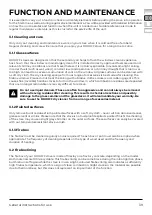
General instructions for use
35
2.2 Fuel quantities
Only use the amount of fuel that you actually need for your heating requirements to avoid unnecessary
emissions. Here’s how to calculate the maximum feed quantity of wood (beech) for your stove:
Example:
Your stove is an intermittent fireplace, which means you have to add fuel at regular intervals. Depending
on the quality of the fuel, the chimney draught and the position of the air slides, it takes about 45 minutes
for a batch to burn.
2.3 Nominal heat output
The actual heat output of a stove is determined by the actual amount of fuel added to it. The nominal
heat output indicates the heat output confirmed and specified in a stove type test according to EN
standards and this information can be found on the type plate. It is necessary to burn a defined amount
of fuel to achieve the nominal heating output. This fuel quantity can be found in the ‘Technical Information’
data sheet.
2.4 Heat output range
Every stove has a heat output range. Less fuel means a lower heat output, while more fuel makes for
a correspondingly higher one. This type of flexibility really pays off. Please refer to the model-specific
‘Technical Information’ data sheet for the heat output range. Please ensure that you do not overload
your stove significantly or permanently, as this will result in overheating. Damage caused by overheating
is not covered by the warranty. With this in mind, only operate your stove in accordance with the model-
specific ‘Technical Information’ data sheet and only add the fuel quantities that you actually need to suit
your heating requirements. Control the heat output and capacity of your stove with the amount of fuel
you add rather than by adjusting the air sliders.
Maximum batch quantity for a nominal
heat output of 8 kW:
Calorific value of 1 kg of chopped beech:
8 / 3.20 * 0.75 hours ≈ 1.9 kg
4.0 kW x 0.8 (80% efficiency) = 3.20 kW
















































